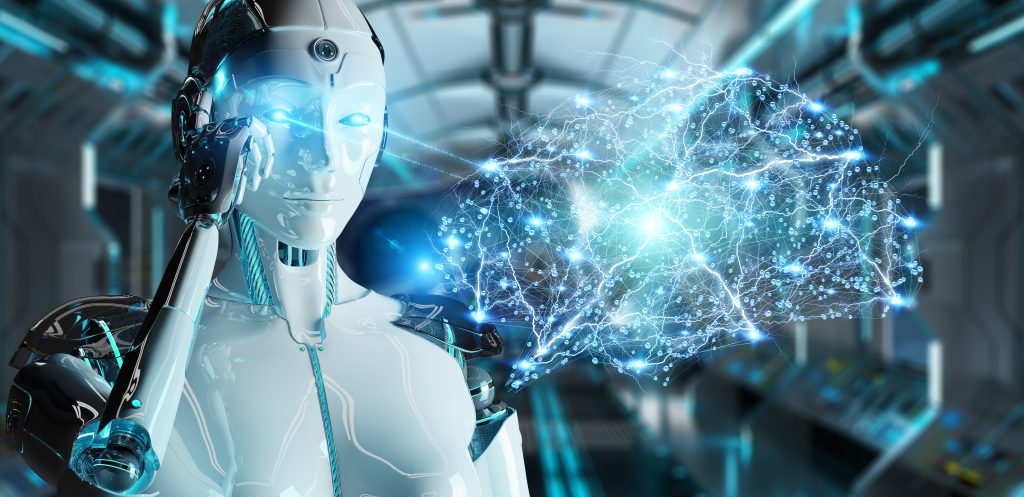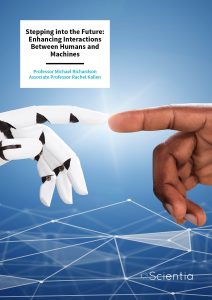Dr Michael Richardson – Dr Rachel Kallen | Stepping into the Future: Enhancing Interactions Between Humans and Machines
Dr Michael Richardson and Dr Rachel Kallen from Macquarie University in Sydney have demonstrated through a wide body of research, that machines can play a vital role in collaborating with humans on perceptual-motor tasks. A key focus of Dr Richardson and Dr Kallen’s cutting-edge research is enhancing the performance of artificial agents using dynamic motor primitives, to create more natural and effective interactions with humans.
Over the last few decades, technology has become an integral part of our lives. Whilst society has largely embraced this leap, there is still some reticence in the acceptance that machines can perform on an equal level to humans or even replace them in undertaking certain tasks. Dr Michael Richardson and Dr Rachel Kallen from the School of Psychological Sciences at Macquarie University in Sydney, Australia, have undertaken a wealth of research exploring how machines can be developed to interact naturally and effectively with humans.
Due to the social nature of the society that we live in, our human behaviours often involve coordinating our actions with others, especially if we have a shared goal. Working with others is more efficient and depends upon our fundamental skills in social perception. Typically, such activities involve us collaborating with other humans. However, Dr Richardson and Dr Kallen are interested in whether artificial agents or machines may be able to play a role in this context, especially given the rapid pace of development in virtual reality and robotic technologies. They believe that artificial agents could help provide perceptual motor training and rehabilitation to humans, as well as assist the elderly or people with disabilities.
The researchers acknowledge that for artificial agents to be accepted within society, they need to have real-time coordination and the ability to respond in a way that is ‘human-like’. To develop this level of performance, the detailed study and modelling of real human actions is required. Much of Dr Richardson and Dr Kallen’s research has focused on testing the effectiveness of dynamic motor primitives, a mathematical formulation of human perceptual-motor behaviour, for controlling the movements and actions of artificial agents. This type of modelling can capture the two main types of motor movement exhibited by humans, which are discrete movements such as reaching or throwing and rhythmic movements such as waving and walking.

Exploring Effective Human-machine Interaction
To assess the effectiveness of artificial agents in collaborative tasks, Dr Richardson and Dr Kallen undertook a study comparing the performance of both human-to-human and human-to-machine pairings. The experimental task involved the pairs working together to herd a small flock of virtual sheep to a specific location. The results revealed that the human and machine performance was the same as for the human-to-human pairings. Importantly, Dr Richardson and Dr Kallen were able to demonstrate that complex human movement and social behaviours can be successfully modelled and implemented by artificial agents, especially when multiple parties are required to work together.
This research is supported by a further study by Dr Richardson and Dr Kallen, which aimed to assess whether artificial agents could naturally undertake ‘pick and place’ activities. These are the kind of actions we undertake daily with those in our households, such as setting the table or loading the dishwasher. The research found that dynamic motor primitives were successful in instructing artificial agents when to pass or not pass an object, as well as which hand movements to make. Another aim of this study was to determine whether humans were able to detect the involvement of a machine in this task. The experimental set-up involved participants wearing virtual reality headsets which masked whether their partner was another human or a machine. They were instructed to work together to move coloured discs from one area of the table to a corresponding target. The results found that at the end of the task the participants were unable to tell if they had been working with a human or a machine. This further supports the researchers’ optimism about the successful involvement of artificial agents within joint human activities.

Enhancing Machine Interactions Based on Human Behaviour
Despite undertaking research which demonstrates successful partnering between humans and artificial agents, Dr Richardson and Dr Kallen have been keen to further explore how these relationships can be further enhanced. Whilst it is important for the behaviour of artificial agents to be perceived as natural by their human partners, it is also vital that machines can cope with the less predictable and more chaotic behaviours displayed by humans. For the interaction to be successful, both humans and machines need to be highly flexible and adaptive. Dr Richardson and Dr Kallen acknowledge that if machines are to play a key role in training, rehabilitation and assistance, then this is a possible barrier that needs to be overcome.
Recently, the researchers have undertaken a study investigating if improvements can be made in how artificial agents deal with chaos. They tested a theory used in cognitive science and psychology that is based on feedback delays in the human perceptual motor system. It was previously thought that processing delays may negatively affect human interactions. But more recently, research has shown very small feedback delays, of a few milliseconds, might help humans to synchronise with and anticipate the actions of another person, even if they are chaotic.
This phenomenon is referred to as ‘anticipatory synchronisation’ and has been applied to human-machine learning by Dr Richardson and Dr Kallen. They found that these micro delays had a positive effect and enhanced machines’ ability to respond to chaotic behaviour. Interestingly, it also enabled the artificial agent to better synchronise their behaviour with humans – this is something that typically only occurs in human-to-human interactions. This demonstrates that principles of our human behaviour can enhance the behaviour of machines, an ethos that is present throughout Dr Richardson and Dr Kallen’s research. They believe the most effective approach is to combine human-inspired strategies and expertise with the more standard computer learning.

Use of Machines in Training
Another key focus of Dr Richardson and Dr Kallen’s research has been the application of artificial agents in training humans, particularly in relation to motor behaviours. Most complex tasks require training for new employees, which often proves to be costly and time-consuming for the organisations involved. Involving machines in this training could be a way to increase efficiency and reduce costs. Interactive artificial agents could take on the training roles typically occupied by humans. However, to be successful artificial agent trainers would need to exhibit natural human behaviour throughout their interactions with trainees.
It has been demonstrated in Dr Richardson and Dr Kallen’s research that the performance of machines can be indistinguishable from that of a human. The use of dynamic motor primitives in the modelling of artificial agents’ behaviours has been heralded as a key factor in generating a high level of performance, a key issue that the researchers have gone on to test within the context of training.
Dr Richardson and Dr Kallen’s research into artificial agent training used another virtual sheep herding task. This time, three different experimental scenarios were employed to assess if machines were able to provide a comparable level of training to human experts. The first and second scenarios explored the performance of human-to-human and human-to-machine pairings, respectively, and the third scenario assessed whether humans could learn successful behaviour from a model-controlled artificial agent. The researchers then measured if the humans were able to transfer these skills to improve their future performance when paired with another human.

The results demonstrated that humans could learn successfully from a machine and were also able to use this to enhance future performances with other human team members. Whilst successful, Dr Richardson and Dr Kallen wanted to establish which type of artificial agent modelling produced the most effective and human-like training performance. To assess if dynamic motor primitives were the most optimum programming principles for artificial trainers, the researchers conducted a further study comparing this with an alternative method called deep reinforcement learning. This alternative approach involves the artificial agent learning how to behave in a specific environment, through trial and error, by performing actions and seeing the results. When comparing this method of modelling through further virtual sheep herding tasks, it was clear that dynamic motor primitive modelling produces the most successful results. Further research has shown that a hybrid of both methods may be the optimum approach.
Dr Richardson and Dr Kallen have demonstrated the critical role that artificial agents can play in the training of motor perception skills across a range of industries including health and sports. Over time, machines will be able to play an increasing role in helping to improve our collaborative behaviours, and have many benefits to offer society. The researchers maintain that there is also much for humans to learn from machines. However, before artificial agents are more widely embraced in our society, greater trust and acceptance are needed from humans. Dr Richardson and Dr Kallen argue that once humans are engaged in working alongside machines as equals, then their true benefits can be realised.
SHARE
DOWNLOAD E-BOOK
REFERENCE
https://doi.org/10.33548/SCIENTIA866
MEET THE RESEARCHERS

Professor Michael Richardson
Department of Psychology
Faculty of Human Sciences
Macquarie University
Sydney
Australia
Dr Michael J. Richardson is a Professor in the School of Psychological Sciences at Macquarie University. He is the Director of the Center for Elite Performance, Expertise and Training and an Australian Research Council Future Fellow. His research is directed towards modelling the dynamics of human perception, action, and cognition and the development of human-machine interaction and AI-based training systems. He has expertise in cognitive science, human factors, complex systems, perception-action, social and multiagent coordination, AI, machine- and deep-learning, simulation and virtual reality, data analytics, and computation and dynamical modelling.
CONTACT
E: michael.j.richardson@mq.edu.au
W: https://researchers.mq.edu.au/en/persons/michael-richardson

Associate Professor Rachel Kallen
Department of Psychology
Faculty of Human Sciences
Macquarie University
Sydney
Australia
Dr Rachel W. Kallen is an Associate Professor in the School of Psychological Sciences at Macquarie University. Her research utilises a framework of complex systems to investigate a range of social behaviours, including how the behavioural dynamics of everyday social and multiagent behaviour emerge from nonlinear interactions of the physical, informational, and social properties of agent-environment systems. Bridging both basic and applied science, her work highlights expertise in areas of social psychology (i.e., stigma, intergroup relations, social cognition), cognitive science, dynamical and computational modelling and analysis, virtual reality, human-machine interaction, AI and machine learning.
CONTACT
E: rachel.w.kallen@mq.edu.au
W: https://researchers.mq.edu.au/en/persons/rachel-kallen
KEY COLLABORATORS
Dr Patrick Nalepka, Macquarie University
Dr Gaurav Patil, Macquarie University
Associate Professor Elliot Saltzman, University of Boston
Professor Mario di Bernardo, University of Naples Federico II
Dr Lilly Rigili, Macquarie University
Dr Maurice Lamb, University of Skövde
Dr Auriel Washburn, University of California, Davis
Professor Anthony Chemero, University of Cincinnati
Fabrizia Auletta, Macquarie University and University of Bristol
FUNDING
Australian Research Council (FT180100447)
Australian Department of Defence, Science and Technology Group (MyIP8655 and HPRNet ID9024)
FURTHER READING
L Rigoli, G Patil, P Nalepka, et al., A comparison of dynamical perceptual-motor primitives and deep reinforcement learning for human-artificial agent training systems, Journal of Cognitive Engineering and Decision Making, 2022, 16(2), 79–100. DOI: https://doi.org/10.1177/15553434221092930
P Nalepka, A Chemero, R Kallen, et al., Human social motor solutions for human-machine interaction in dynamical task contexts, Proceedings of the National Academy of Sciences, 2019, 116, 4, 1437–1446. DOI: https://doi.org/10.1073/pnas.1813164116
A Washburn, R Kallen, M Lamb, et al., Feedback delays can enhance anticipatory synchronization in human-machine interaction, PloS One, 2019, 14(8), e0221275. DOI: https://doi.org/10.1371/journal.pone.0221275

REPUBLISH OUR ARTICLES
We encourage all formats of sharing and republishing of our articles. Whether you want to host on your website, publication or blog, we welcome this. Find out more
Creative Commons Licence (CC BY 4.0)
This work is licensed under a Creative Commons Attribution 4.0 International License. 
What does this mean?
Share: You can copy and redistribute the material in any medium or format
Adapt: You can change, and build upon the material for any purpose, even commercially.
Credit: You must give appropriate credit, provide a link to the license, and indicate if changes were made.
SUBSCRIBE NOW
Follow Us
MORE ARTICLES YOU MAY LIKE
Dr Ralf Adam | New Technologies Shaping the Future of Oral Hygiene
Understanding the efficiency of various toothbrush technologies is essential for achieving optimal oral health. Dr Ralf Adam, who leads a dedicated team at Procter & Gamble in Germany, is keen to investigate the complexities of these technologies. His team have provided new insights into the best toothbrush types for plaque removal and the maintenance of gum health. By highlighting the importance of informed oral care decisions and ongoing investigations, this vital research works towards ensuring everyone can achieve a brighter, healthier smile.
Dr Toby Phesse | Revealing the Mysteries of Wnt Signalling: Novel Approaches to Beating Cancer
Cancer remains a leading cause of mortality worldwide, and the need for new, more effective treatments remains an urgent challenge. Dr Toby Phesse from Cardiff University in the UK focuses on the role of the Wnt receptor found on the surface of cells and its involvement with cell communication and cancer growth, bringing fresh hopes for new therapeutic options.
Dr Vijay Reddy | The Virus World Database: An Invaluable Resource for Public Health and Healthcare
Severe viral disease presents an ongoing challenge to the health of humankind. While unparalleled developments in science and technology are improving our understanding of such viruses, this information needs to be readily accessible to researchers to ensure continued progress in public health and healthcare. Dr Vijay Reddy and his colleagues at the Hormel Institute (University of Minnesota) developed the Virus World database, an invaluable resource that details the genome, structure, and host of practically every discovered virus to date.
Professor Ralf Herwig | Deciphering the Enigma of Vitamin D and the Immune System
Vitamin D has been studied as a treatment for a large number of diseases and conditions, from cancer to autism to COVID-19. However, its mode of action is not completely understood. Professor Ralf Herwig carries out his research at HG Pharma GmbH (Austria) and Ulster University (UK). His vital work explores the role of vitamin D in the body with a view to unlocking its potential as a treatment for a variety of health conditions involving the immune system.





